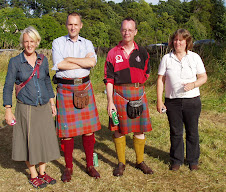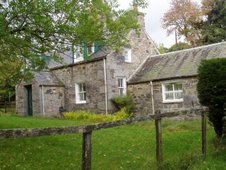Full speed ahead with the Calcutta Cup ’06 yoke. The rounds are lengthy, but nothing like a row of Princess-border-knitting – and they’re getting shorter, by eight stitches every two rounds. The difference will be sensible soon. I continue pleased both with progress and with the anticipated result.
I had a moment, the other day, of imagining a future when it’s finished which would consist of months divided between Princess-knitting and The Yarn Yard club offering. But where would that leave cashmere Koigu – the Shapely Shawlette, and Theo’s Barak-electing sweater? Life is too short.
My friend the Socklady recently sent me, out of sheer kindness, a substantial booklet by Therese de Dillmont (called “Knitting IIIrd Series”). It consists of lace edgings and insertions, and it’s seriously good.
 For de Dillmont, see Bishop Rutt’s History of Hand Knitting. The booklet is undated, but he says that she died in 1890, which makes it somewhat earlier than I would have guessed. I have tried, rather gingerly, to scan a page without straining the binding.
For de Dillmont, see Bishop Rutt’s History of Hand Knitting. The booklet is undated, but he says that she died in 1890, which makes it somewhat earlier than I would have guessed. I have tried, rather gingerly, to scan a page without straining the binding.
The instructions seem very lucid, although not framed in the language we are used to. “1 over, 1 purled intake, knit 2, 1 purled intake, 2 overs…” I think I could do it if I set myself to it, but reading through the instructions filled me with renewed admiration for Jane Sowerby, who struggled with far worse when she was working on Victorian Lace Today – and with such magnificent results.
De Dillmont isn’t included in that book. Her work was early translated into English, but Sowerby restricts herself (wisely, I think) to actual English sources. Therese de Dillmont’s magnum opus is her Encyclopedia of Needlework. I’ve got it – in fact, it was one of my husband’s family books and came to our shelves with marriage many decades ago.
Place and Nationality
Yes, Dawn, I feel American, perhaps increasingly with age. There are days at a stretch when it doesn’t occur to me, and when I forget that (as you say, Janet) I identify myself whenever I open my mouth. I haven’t been to America for more than four years now: I find it confusing. I don’t understand, any longer, how to do things there. But that’s another matter. At least both you and I have taken rugby on board, Janet. I fear Ireland is going to make mincemeat of Scotland this year.
Jean, where is Carshalton? Is that suburban Surrey? James and Cathy have just bought a house there, although they don’t have much ides when they will leave Beijing and come and live in it. So perhaps one day I will be familiar with that part of the world.
I had the feeling you mention, about Celticness, very strongly when granddaughter Kirsty, James and Cathy’s daughter, was baptised in Gulval, a village near Penzance. Cathy’s father is a Cornishman, and lots of family remains in the vicinity. I left Edinburgh on a bonny, sunny day, travelled through frost and ice through England, and felt at the end not only that I had travelled through winter back into spring, but also through a different land, and I that I was back among Celts. Some of Cathy’s cousins are market gardeners. I talked at the party about potato-growing, and I remember that one does not mention Jersey Royals to a Cornish potato farmer.
I had a moment, the other day, of imagining a future when it’s finished which would consist of months divided between Princess-knitting and The Yarn Yard club offering. But where would that leave cashmere Koigu – the Shapely Shawlette, and Theo’s Barak-electing sweater? Life is too short.
My friend the Socklady recently sent me, out of sheer kindness, a substantial booklet by Therese de Dillmont (called “Knitting IIIrd Series”). It consists of lace edgings and insertions, and it’s seriously good.
 For de Dillmont, see Bishop Rutt’s History of Hand Knitting. The booklet is undated, but he says that she died in 1890, which makes it somewhat earlier than I would have guessed. I have tried, rather gingerly, to scan a page without straining the binding.
For de Dillmont, see Bishop Rutt’s History of Hand Knitting. The booklet is undated, but he says that she died in 1890, which makes it somewhat earlier than I would have guessed. I have tried, rather gingerly, to scan a page without straining the binding.The instructions seem very lucid, although not framed in the language we are used to. “1 over, 1 purled intake, knit 2, 1 purled intake, 2 overs…” I think I could do it if I set myself to it, but reading through the instructions filled me with renewed admiration for Jane Sowerby, who struggled with far worse when she was working on Victorian Lace Today – and with such magnificent results.
De Dillmont isn’t included in that book. Her work was early translated into English, but Sowerby restricts herself (wisely, I think) to actual English sources. Therese de Dillmont’s magnum opus is her Encyclopedia of Needlework. I’ve got it – in fact, it was one of my husband’s family books and came to our shelves with marriage many decades ago.
Place and Nationality
Yes, Dawn, I feel American, perhaps increasingly with age. There are days at a stretch when it doesn’t occur to me, and when I forget that (as you say, Janet) I identify myself whenever I open my mouth. I haven’t been to America for more than four years now: I find it confusing. I don’t understand, any longer, how to do things there. But that’s another matter. At least both you and I have taken rugby on board, Janet. I fear Ireland is going to make mincemeat of Scotland this year.
Jean, where is Carshalton? Is that suburban Surrey? James and Cathy have just bought a house there, although they don’t have much ides when they will leave Beijing and come and live in it. So perhaps one day I will be familiar with that part of the world.
I had the feeling you mention, about Celticness, very strongly when granddaughter Kirsty, James and Cathy’s daughter, was baptised in Gulval, a village near Penzance. Cathy’s father is a Cornishman, and lots of family remains in the vicinity. I left Edinburgh on a bonny, sunny day, travelled through frost and ice through England, and felt at the end not only that I had travelled through winter back into spring, but also through a different land, and I that I was back among Celts. Some of Cathy’s cousins are market gardeners. I talked at the party about potato-growing, and I remember that one does not mention Jersey Royals to a Cornish potato farmer.




Carshalton sure is Suburban Surrey - about 20 miles west and closer into London than me. Well within reach of some splendid wool shops though, and, if you ever show signs of coming this way, I will tell you about them.
ReplyDeleteYou certainly don't mention Jersey Royals to a Cornish farmer! Gulval is on that south-facing slope, and the land has been enriched with tons of seaweed over the years, so that it is known as the golden mile from the crops of potatoes and cauliflower, known locally as "broccolow". When I was young, the cheap way to get to London was by Broccolow Lorry - they travelled overnight to Covent Garden every night except Sunday in the season.
Glad that you do find the little book interesting, especially after its round about journey getting there.
ReplyDeletesigh--those edgings are so pristine and beautiful....
ReplyDeleteThe edging is beautiful and inspiring. Thanks for posting the image.
ReplyDeleteHi Jean,
ReplyDeleteI'm pretty sure that "1 purl intake" just means p2tog.
I've been working on http://www.knitting-and.com/homework for several years and am finding patterns from the 1800's easier to understand as I go along.
Sarah
At last I know the origins of 'broccolow'. My grandfather occasionally used it, although he was a thorough Yorkshireman.
ReplyDelete